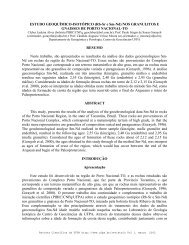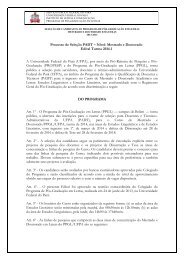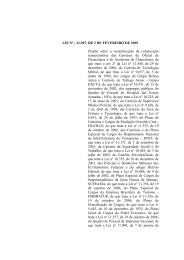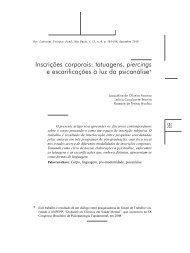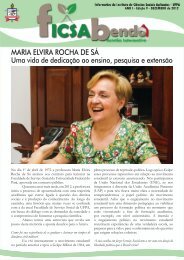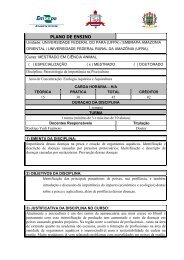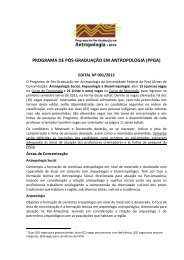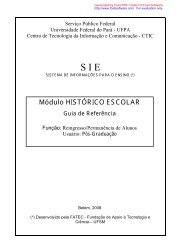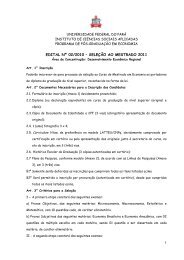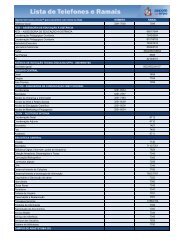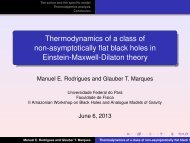Pb/ Pb-ages of zircons from syn-collisional I-type porphyritic granites ...
Pb/ Pb-ages of zircons from syn-collisional I-type porphyritic granites ...
Pb/ Pb-ages of zircons from syn-collisional I-type porphyritic granites ...
Create successful ePaper yourself
Turn your PDF publications into a flip-book with our unique Google optimized e-Paper software.
Gondwana Research 9 (2006) 326 – 336www.elsevier.com/locate/gr207 <strong>Pb</strong>/ 206 <strong>Pb</strong>-<strong>ages</strong> <strong>of</strong> <strong>zircons</strong> <strong>from</strong> <strong>syn</strong>-<strong>collisional</strong> I-<strong>type</strong> <strong>porphyritic</strong><strong>granites</strong> <strong>of</strong> the central Ribeira belt, SE BrazilJulio Cezar Mendes a, * ,1 , Ciro Alexandre Ávila b , Ronaldo Mello Pereira c ,Mônica P.L. Heilbron c,1 , Candido A.V. Moura d,1a Departamento de Geologia, IGEO-Universidade Federal do Rio de Janeiro (UFRJ), Cidade Universitária, 21949-900, Rio de Janeiro, Brasilb Departamento de Geologia e Paleontologia, Museu Nacional, Universidade Federal do Rio de Janeiro (UFRJ),Quinta da Boa Vista, 20940-040, Rio de Janeiro, Brasilc Faculdade de Geologia, Universidade do Estado do Rio de Janeiro (UERJ), Rua São Francisco Xavier, 524, 20550-013, Rio de Janeiro, Brasild Departamento de Geoquímica e Petrologia, Universidade Federal do Pará, Rua Augusto Correa 1, 66075-110, Belém, BrasilReceived 15 February 2005; accepted 9 November 2005Available online 10 January 2006AbstractIn the central segment <strong>of</strong> the Ribeira belt, southeast Brazil, several foliated <strong>porphyritic</strong> granitic bodies intrude high-grade migmatitic gneisses<strong>of</strong> the Andrelândia and Juiz de Fora domains and Embú Complex. Results <strong>of</strong> geological, geochemical and geochronological investigations <strong>of</strong> theMaromba, Pedra Selada, Serra do Lagarto and Funil <strong>porphyritic</strong> I-<strong>type</strong> <strong>granites</strong> provide pr<strong>of</strong>ound similarities, except for the distinct geochemicalbehavior <strong>of</strong> the Funil Granite, perhaps related to a different crustal source. These granitoids show similar structural, textural and mineralogicalfeatures. <strong>Pb</strong>-evaporation <strong>of</strong> single <strong>zircons</strong> provided <strong>ages</strong> <strong>of</strong> 586T6, 579.6T6.3, 586.3T4.8 and 584T5 Ma for the <strong>granites</strong>, respectively, coincidentwith the <strong>syn</strong>-collision I episode <strong>of</strong> the central Ribeira belt. The intrusion <strong>of</strong> I-<strong>type</strong> <strong>porphyritic</strong> granitoids coeval with the main <strong>collisional</strong> event hasnot <strong>of</strong>ten been reported in the geological literature. The most common <strong>syn</strong>-<strong>collisional</strong> granitic magmatism has normally an S-<strong>type</strong> signature oreven a slightly peraluminous I-<strong>type</strong> character. However, the occurrence <strong>of</strong> coeval I- and S-<strong>type</strong> <strong>syn</strong>-tectonic <strong>granites</strong> along the central Ribeira belt,as observed in the investigated area and discussed in this paper is noteworthy.D 2005 International Association for Gondwana Research. Published by Elsevier B.V. All rights reserved.Keywords: Central Ribeira belt; Neoproterozoic <strong>granites</strong>; Western Gondwana; 207 <strong>Pb</strong>/ 206 <strong>Pb</strong> geochronology1. Introduction and tectonic settingThe Neoproterozoic Ribeira orogenic belt extends overmore than 1000 km along the southeastern coast <strong>of</strong> Brazil (Fig.1). It developed as the result <strong>of</strong> the amalgamation <strong>of</strong> WesternGondwana during the Brasiliano/PanAfrican orogenic episodes.Reported geochronological data indicate that orogenicactivity was diachronic along the supercontinent, ranging intime <strong>from</strong> ca. 900 to 480 Ma.Four major orogenic episodes have been recognized in theRibeira belt (Machado et al., 1996; Heilbron et al., 1995, 2000,* Corresponding author.E-mail addresses: julio@geologia.ufrj.br (J.C. Mendes),avila@mn.ufrj.br (C.A. Ávila), rmello@uerj.br (R.M. Pereira),heilbron@uerj.br (M.P.L. Heilbron), candido@ufpa.br (C.A.V. Moura).1 CNPq (National Research Council).2004; Trouw et al., 2000; Campos Neto, 2000; Heilbron andMachado, 2003; Schmitt et al., 2004): a) 790 to 600 Masubduction and magmatic arc generation; b) 600 to 560 Macollision I episode; c) 530 to 510 Ma collision II episode; andd) 510 to 480 Ma orogenic collapse.Collision I episode (600 to 560 Ma) is the most importantorogenic event along the Ribeira belt and its northerncounterpart, the Araçuaí belt. This tectonic episode ischaracterized by widespread generation <strong>of</strong> granitoids. Threecommon <strong>type</strong>s <strong>of</strong> granitoids, related to this episode, areleuco<strong>granites</strong>, <strong>porphyritic</strong> (hornblende)-biotite <strong>granites</strong> andhornblende <strong>granites</strong>.Between the towns <strong>of</strong> Itatiaia, Visconde de Mauá and SantaRita de Jacutinga, in the Minas Gerais/Rio de Janeiro/SãoPaulo state boundaries, voluminous and important <strong>porphyritic</strong>granitoid magmatism was recognised and studied by Heilbron(1993), Junho et al. (1999) and Pereira et al. (2001a). Ona1342-937X/$ - see front matter D 2005 International Association for Gondwana Research. Published by Elsevier B.V. All rights reserved.doi:10.1016/j.gr.2005.11.004
J.C. Mendes et al. / Gondwana Research 9 (2006) 326–336 327Fig. 1. Tectonic map <strong>of</strong> Brazil modified after Schobbenhaus et al. (1984). Legend: 1—Phanerozoic basins; 2—Bambuí group; 3—Neoproterozoic orogens; 4—Cratons (A—Amazon, B—São Luis, C—São Francisco, D—Luis Alves, E—Rio de la Plata).regional scale, it is important to stress the occurrence <strong>of</strong> coeval<strong>syn</strong>-<strong>collisional</strong>, I-<strong>type</strong> <strong>porphyritic</strong> and S-<strong>type</strong> <strong>granites</strong> in theRibeira belt.The purpose <strong>of</strong> this paper is the presentation <strong>of</strong> new zircon<strong>Pb</strong>-evaporation <strong>ages</strong> <strong>of</strong> four major plutons representative <strong>of</strong> the<strong>porphyritic</strong> I-<strong>type</strong> <strong>syn</strong>-collision I magmatism <strong>of</strong> the belt(Maromba, Pedra Selada, Serra do Lagarto and Funil) andthe discussion <strong>of</strong> their geological and geochemical data in thecontext <strong>of</strong> the Gondwana amalgamation.2. Tectonic organization and regional geologyThe central segment <strong>of</strong> the Ribeira belt is subdivided in fivedistinct tectonic terranes, in the sense <strong>of</strong> Howell (1989). Theseare: Occidental, Paraíba do Sul, Embú, Oriental and Cabo FrioTerranes (Heilbron et al., 2000, 2004). The investigated plutonsare located in the Occidental and Embú Terranes (Fig. 2).The Occidental Terrane is subdivided in two structuraldomains named Andrelândia and Juiz de Fora (Fig. 2). Bothcontain three units: a) an older Paleoproterozoic basement (theMantiqueira Complex in the Andrelândia Domain and the Juizthe Fora Complex in the Juiz de Fora Domain); b) a highlydeformed and metamorphic cover association (Andrelândiamegasequence) and c) Neoproterozoic granitoids. The Paleoproterozoicbasement association includes hornblende andbiotite migmatitic orthogneisses (Mantiqueira complex) andvaried orthogranulites (Juiz de Fora complex). The Andrelândiamegasequence includes banded biotite gneisses withquartzites, amphibolites and pelitic gneisses, and sillimanite–garnet–bitotite gneisses with several layers <strong>of</strong> calcsilicaterocks, gondites, amphibolites and quartzites. As pointed outby Junho et al. (1999), in the studied area, the extensivemigmatization transformed the paragneisses in stromaticmetatexites, crosscut by multiple leucosomatic veins, whichprogressively grade into (garnet)–biotite–muscovite graniticleucogneiss. In the northwestern part <strong>of</strong> the investigated area,in the Carvalhos Klippe, high-pressure granulites weredescribed <strong>from</strong> the Andrelândia megasequence (Trouw et al.,2000; Campos Neto and Caby, 2000).The Paraíba do Sul and Embú Terranes also containbasement and supracrustal associations (Eirado et al., in press).In the former terrane, basement is represented by the QuirinoComplex and other orthogneisses, while the Neoproterozoiccover, named Paraíba do Sul Group or Complex is composed<strong>of</strong> pelitic gneisses, schists, calcsilicate rocks and marbles. Inthe Embú Terrane, cover consists <strong>of</strong> tourmaline rich peliticgneisses and schists with quartzitic layers, while basementassociations are represented by hornblende orthogneisses(Fernandes et al., 1990; Almeida et al., 1993; Pereira, 2001;Heilbron et al., 2004).Local structures are subdivided in two deformational pulses,correlated to regional deformations D 1 +D 2 and D 3 <strong>of</strong> Ribeiroet al. (1995) and Heilbron et al. (1995, 2000). The oldest one,D 1 +D 2 , created the main foliation, locally mylonitic, and tightto isoclinal inclined to subhortizontal folds that repeat andthicken the units. In the Juiz de Fora domain, an important
328J.C. Mendes et al. / Gondwana Research 9 (2006) 326–336Fig. 2. Simplified tectonic map <strong>of</strong> Santa Rita do Jacutinga–Resende–Bananal region, modified after Heilbron et al. (2004). Geological data were compiled <strong>from</strong>Silva et al. (1992), Heilbron (1993), Ribeiro et al. (1995), Almeida et al. (1993), Pereira (2001), Eirado et al. (in press). Legend: 1—Alkaline Phanerozoic plutons;2—Phanerozoic basins; 3—Syn-collision II granitoids (ca. 530 Ma); 4—S-<strong>type</strong> <strong>syn</strong>-collision I granitoids (ca. 580 Ma); 5—I-<strong>type</strong> <strong>syn</strong>-collision I granitoids (ca. 580Ma); 6—Hornblende granitoids <strong>of</strong> uncertain age; 7—Embú Terrane; 8—Paraíba do Sul Terrane; 9–11 Structural domains <strong>of</strong> the Occidental Terrane: 9—Juiz de Fora(JFD), 10—Andrelândia (ANDD) and 11—Carvalhos klippe <strong>of</strong> the Occidental Terrane; 12—Faults; 13—Normal faults; 14—Lateral shear zones; 15—Mainfoliation; 16—Major thrusts; 17—Synform; 18—Antiform; 19—Geochronological sampling, with abbreviation <strong>of</strong> the name <strong>of</strong> the investigated plutons representedby capital letters: M=Maromba; PS=Pedra Selada; SL=Serra do Lagarto; FU=Funil. Major towns are Bom Jardim de Minas (BM), Resende (RE), Volta Redonda(VR), and Santa Rita de Jacutinga (SRJ).tectonic imbrication mixed cover and basement rocks in severalthrust slices. The D 3 phase refolded the previous structures,generating open to tight folds with steep axial surfaces and SWplunging axes. In the Andrelândia domain, in the northernsector <strong>of</strong> the investigated area (Fig. 2), the interference betweenD 1 +D 2 and D 3 phases resulted in dome-and-basin andrefolded-fold patterns shown on the map. In the central andsouthern sector <strong>of</strong> the area, D 3 developed important subverticalshear zones, such as the Além Paraíba, Alto da Fartura andCubatão shear zones.The rocks <strong>of</strong> the region underwent <strong>syn</strong>-D 2 barrovianmetamorphism, with increasing temperatures and mediumpressure (Heilbron, 1993, Trouw et al., 2000). The regionalmetamorphism culminated with the formation <strong>of</strong> migmatitesand <strong>granites</strong> in the basal feldspathic metasedimentary rocks <strong>of</strong>the Andrelândia megasequence (Ribeiro et al., 1995). Asmentioned above, the migmatitic rocks were subdivided intotwo units grading into each other: a stromatic biotite gneisswith metatexitic structures and a (garnet)–muscovite–biotitediatexitic leucogneiss. Both are intruded by post-D 2 finegrainedequigranular leucogranite containing garnet, tourmaline,biotite and muscovite. It crops out as minor concordantlenses or as dykes and sills. Both the diatexite and the intrusiveleucogranite result <strong>from</strong> progressive partial melting <strong>of</strong> the
330J.C. Mendes et al. / Gondwana Research 9 (2006) 326–336Fig. 4. Shand’s diagram for the <strong>porphyritic</strong> I-<strong>type</strong> <strong>granites</strong>. Symbols as in Fig.3.In this paper, geochemical data <strong>of</strong> <strong>porphyritic</strong> <strong>granites</strong> <strong>from</strong>Heilbron (1993), Junho et al. (1999) and Pereira et al. (2001a)are ploted in selected diagrams, as discussed below. The AFMand Shand’s diagrams (Figs. 3 and 4) reinforce the calc-alkalineand metaluminous to slightly peraluminous signature <strong>of</strong> the<strong>granites</strong>. It must be emphasized that towards the most evolvedmagmas <strong>of</strong> an acid I-<strong>type</strong> igneous sequence there is a tendencyto crystallize slightly peraluminous rocks (Clarke, 1981).The Harker diagrams (Fig. 5) show the SiO 2 range <strong>of</strong> the<strong>granites</strong>. The more evolved character <strong>of</strong> the samples <strong>from</strong>Maromba and Funil <strong>granites</strong> contrasts with the less evolved<strong>from</strong> the Pedra Selada granite. From field and petrographicobservations, as well as linear trends observed in theSiO 2 Fe 2 O 3 , MgO, CaO, P 2 O 5 , Ba and Sr variation diagrams,a genetic link <strong>of</strong> Maromba, Pedra Selada and Serra do Lagarto<strong>granites</strong> may be inferred. The Funil granite represents the moreFig. 5. Harker diagrams for the <strong>porphyritic</strong> I-<strong>type</strong> <strong>granites</strong>. Symbols as in Fig. 3.
J.C. Mendes et al. / Gondwana Research 9 (2006) 326–336 331Fig. 6. Chondrite-normalized REE diagrams for the <strong>porphyritic</strong> I-<strong>type</strong> <strong>granites</strong>. Symbols as in Fig. 3. Normalization values <strong>from</strong> Boynton (1984). (A) Funil Granite,(B) Serra do Lagarto Granite, (C) Maromba Granite and (D) Pedra Selada Granite.acid part <strong>of</strong> the trend, whereas the Pedra Selada granite formsthe more basic one. On the other hand, in some diagrams theFunil granite samples tend to be clustered and do not fit verywell in the assumed trends (e.g. SiO 2 Fe 2 O 3 , CaO, Ba andSr). This behavior is also apparent in Figs. 3, 6 and 7).The preferential occurrence <strong>of</strong> quartzdioritic microgranularenclaves in the Pedra Selada and Serra do Lagarto <strong>porphyritic</strong><strong>granites</strong> could indicate prior assimilation and/or contaminationprocess.The REE patterns <strong>of</strong> Fig. 6 highlight the probable cogeneticlink between the Maromba, Pedra Selada and Serra do Lagarto<strong>porphyritic</strong> I-<strong>type</strong> <strong>granites</strong>. They have quite similar REEdistribution pattern, showing to be highly fractionated with aclear negative Eu anomaly. The Pedra Selada granite shows thehighest total REE content. REE concentrations <strong>of</strong> the Marombagranite are lower than that <strong>of</strong> the Pedra Selada granite despiteits highest SiO 2 content.The well developed negative Eu anomaly in some patterns<strong>of</strong> the Funil granite is possibly caused by feldspar extractionduring fractional crystallization processes. However, its lessfractionated REE patterns and the strong negative Eu anomalycontrast with all others. The HREE enriched flat pattern may beassociated with sphene and zircon modal abundance, buthybridization processes could also provoke changes in the REEconcentrations <strong>of</strong> the melt, as pointed out by Dini et al. (2004).The different REE distribution <strong>of</strong> the Funil granitereinforces its possible more evolved character, maybe relatedto a different crustal source associated with the Embu Complexhost rocks, while the Maromba, Pedra Selada and Serra doLagarto <strong>granites</strong> are surrounded by the Andrelândia and Juiz deFora domains. Further achievement <strong>of</strong> isotopic Sr and Ndanalyses possibly will provide adequate elements to elucidatethis assumption.In the R 1 R 2 diagram (Fig. 7), after Batchelor and Bowden(1985), two trends can be envisaged: one <strong>from</strong> field 6 (<strong>syn</strong>collisionfield) to field 4 (late-orogenic field) and the other<strong>from</strong> field 6 to field 7 (post-orogenic field). The former may beassociated with the formation <strong>of</strong> I-<strong>type</strong> <strong>granites</strong> during <strong>syn</strong>-tolate-orogenic processes. The alignment <strong>of</strong> granite samplesseems to reflect the evolution <strong>from</strong> less evolved metaluminousto more evolved, slightly peraluminous granitic magma, in a<strong>syn</strong>-tectonic environment.5. 207 <strong>Pb</strong>/ 206 <strong>Pb</strong> geochronology5.1. SamplingFig. 7. R 1 R 2 diagram for the <strong>porphyritic</strong> I-<strong>type</strong> <strong>granites</strong>. Symbols as in Fig. 3.Fields <strong>from</strong> Batchelor and Bowden, 1985.Zircon crystals were extracted <strong>from</strong> samples <strong>of</strong> Maromba,Pedra Selada and Serra do Lagarto <strong>porphyritic</strong> I-<strong>type</strong> <strong>granites</strong>(Fig. 2), after crushing, sieving, panning and concentrationusing Frantz magnetic separation and heavy liquid (bromo-
332J.C. Mendes et al. / Gondwana Research 9 (2006) 326–336Table 1207 <strong>Pb</strong>/ 206 <strong>Pb</strong> data for single <strong>zircons</strong> <strong>of</strong> the Maromba GraniteZircon Description Evaporation T (C-) Measured ratios204 <strong>Pb</strong>/ 206 <strong>Pb</strong>207 <strong>Pb</strong>/ 206 <strong>Pb</strong>207 <strong>Pb</strong>/ 206 <strong>Pb</strong>* Age (Ma) Zircon age (Ma)1 euh, stpr, tr, py 1450 32 0.000050T39 0.06081T29 0.05984T41 598T151500 36 0.000038T05 0.06029T22 0.05975T24 595T091550 38 0.000108T20 0.06050T324 0.05901T21 568T08 581.7T19.62 euh, lgpr, tr, py 1450 40 0.000047T03 0.06033T08 0.05970T09 593T031500 34 0.000057T11 0.06006T11 0.05925T10 576T04 585.5T16.43 ‘ euh, lgpr, tr, py 1500 38 0.000015T02 0.05993T24 0.05972T27 594T101550 40 0.000038T04 0.06239T15 0.06183T09 669T034 euh, stpr, tr, py 1500 40 0.000162T13 0.06174T28 0.05935T35 580T13 580T135 euh, lgpr, tr, py 1450 16 0.000202T06 0.06247T13 0.05957T21 588T08 588T086 euh, stpr, tr, py 1450 # 0 0.000312T28 0.06198T25 0.05744T48 509T181500 34 0.000104T09 0.06143T15 0.05958T54 589T20 589T208 sbh, stpr, tr, py 1500 36 0.000012T06 0.05990T13 0.05975T19 595T07 595T0714 euh, lgpr, tr, py 1500 40 0.000031T07 0.06019T26 0.05963T35 591T13 591T13Average age586T6Uncertainties are given at 2r.# Heating steps not used in the age calculation; * 207 <strong>Pb</strong>/ 206 <strong>Pb</strong> ratio corrected for common <strong>Pb</strong> contamination; ‘ inherited zircon. Description <strong>of</strong> the zircon crystals:euh=euhedral; sbh=subhedral; stpr=short prism (l /w between 1 and 3); lgpr=long prism (l /w >3); tr=transparent; py=pale yellowish.form). Zircons <strong>from</strong> the less magnetic fractions were selectedbecause they tend to be more concordant (Krogh, 1982).The analyzed non-magnetic <strong>zircons</strong> are transparent tooccasionally translucent, colorless, pale yellowish or pink.Bipyramidal prism length varies <strong>from</strong> long (width vslength=15) to short (width vs length=12) and the grainssometimes display subhedral morphology (Tables 1 2 and 3).5.2. Analytical techniquesGeochronological analyses by <strong>Pb</strong>-evaporation technique in<strong>zircons</strong> (Kober, 1986, 1987) were carried out at theLaboratory <strong>of</strong> Isotope Geology <strong>of</strong> the Federal University <strong>of</strong>Pará (Pará-Iso).Zircon is a heavy mineral with crystalline structure veryresistant to alteration and it tends to preserve the isotopicinformation since its crystallization. Kober (1986) has shownthat the <strong>Pb</strong> components with the highest activation energynormally reside in the intact crystalline zircon phase that showsno post-crystallization <strong>Pb</strong>-loss and consequently yields concordant207 <strong>Pb</strong>/ 206 <strong>Pb</strong> <strong>ages</strong>. The progressive heating <strong>of</strong> a zirconcrystal during the <strong>Pb</strong>-evaporation techniques gradually releases<strong>Pb</strong> isotopes. The theoretical basis for this technique is that theactivation energy necessary to release <strong>Pb</strong> <strong>from</strong> damaged ormetamict zones <strong>of</strong> zircon are much less than <strong>from</strong> crystallinedomains (Kober, 1986). Thus, radiogenic <strong>Pb</strong> <strong>from</strong> metamictzones can be purged at relatively lower evaporation temperatures,while radiogenic <strong>Pb</strong> <strong>from</strong> crystalline domains in zircon isreleased only at higher temperatures (Ansdell and Kyser,1993).Isotope analyses on <strong>porphyritic</strong> I-<strong>type</strong> <strong>granites</strong> wereperformed on a Finnigan MAT 262 thermo-ionization massspectrometer (TIMS) using the stepwise heating process(Kober, 1986, 1987) with a double-filament arrangement(evaporation and ionization). In this procedure, the zirconwas mounted on the canoe-shape rhenium evaporation filament,positioned in front <strong>of</strong> the rhenium ionization filament.Initially, the ionization filament was heated, in order to becleaned. Afterward, the evaporation filament was heated(evaporation step) to allow structurally bound radiogenic <strong>Pb</strong>to diffuse out <strong>of</strong> the crystal. The <strong>Pb</strong> was deposited on the coldionization filament that was, subsequently, heated releasing thedeposited <strong>Pb</strong> for isotope determinations. The isotope data wereacquired dynamically using the ion counting system <strong>of</strong> theinstrument, with the intensity <strong>of</strong> the 207 <strong>Pb</strong> beam between30,000 and 100,000 counts per second (cps). The intensity <strong>of</strong>different <strong>Pb</strong> isotopes were measured in the mass sequence206 <strong>Pb</strong>, 207 <strong>Pb</strong>, 208 <strong>Pb</strong>, 206 <strong>Pb</strong>, 207 <strong>Pb</strong>, 204 <strong>Pb</strong>. Ten (10) mass scanTable 2207 <strong>Pb</strong>/ 206 <strong>Pb</strong> data for single <strong>zircons</strong> <strong>of</strong> the Pedra Selada GraniteZircon Description Evaporation T(C-) Measured ratios204 <strong>Pb</strong>/ 206 <strong>Pb</strong>207 <strong>Pb</strong>/ 206 <strong>Pb</strong>207 <strong>Pb</strong>/ 206 <strong>Pb</strong> (*) Age (Ma) Zircon age (Ma)3 sbh, stpr, tl, py 1500 34 0.000169T04 0.06188T13 0.05946T18 584T07 584T075 euh, lgpr, tl, py 1500 28 0.000106T16 0.06077T28 0.05905T18 569T07 569T077 euh, stpr, tl, py 1500 30 0.000108T12 0.06057T18 0.05886T37 562T14 562T1413 euh, lgpr, tl, py 1500 30 0.000048T05 0.06005T19 0.05929T18 578T07 578T0714 euh, lgpr, tl, py 1500 32 0.000378T02 0.06491T18 0.05948T25 585T091550 8 0.000395T28 0.06504T54 0.05931T68 579T25 584.2T8.615 euh, lgpr, tl, py 1450 32 0.000197T49 0.06217T36 0.05965T42 591T151500 16 0.000040T04 0.06024T24 0.05966T25 591T09 .3T7.7Average age579.6T6.3Uncertainties are given at 2r.* 207 <strong>Pb</strong>/ 206 <strong>Pb</strong> ratio corrected for common <strong>Pb</strong> contamination. Description <strong>of</strong> the zircon crystals: euh=euhedral; sbh=subhedral; stpr=short prism (l /w between 1 and3); lgpr=long prism (l /w >3); tl=translucent; py=pale yellowish.
J.C. Mendes et al. / Gondwana Research 9 (2006) 326–336 333Table 3207 <strong>Pb</strong>/ 206 <strong>Pb</strong> data for single <strong>zircons</strong> <strong>of</strong> the Serra do Lagarto GraniteZircon Description Evaporation T(C-) Measured ratios204 <strong>Pb</strong>/ 206 <strong>Pb</strong>207 <strong>Pb</strong>/ 206 <strong>Pb</strong>207 <strong>Pb</strong>/ 206 <strong>Pb</strong> (*) Age (Ma) Zircon age (Ma)1 euh, lgpr, tr, cl 1450 30 0.000036T05 0.05998T21 0.05945T16 584T061500 28 0.000038T04 0.06029T17 0.05948T22 585T08 584.3T4.72 euh, stpr, tr, cl 1450 # 0 0.000448T36 0.06634T69 0.05985T87 598T321500 08 0.000136T08 0.06176T35 0.05979T37 596T13 596.3T13.43 euh, lgpr, tr, cl 1450 40 0.000170T03 0.06183T20 0.05932T24 579T091500 T38 0.000150T09 0.06130T13 0.05962T29 590T11 583.6T10.64 euh, lgpr, tr, cl 1450 36 0.000102T06 0.06079T22 0.05939T22 582T081500 32 0.000156T06 0.06122T27 0.05920T16 575T06 577.2T6.85 euh, stpr, tr, cl 1450 # 0 0.001416T34 0.07991T64 0.05950T94 586T341500 36 0.00131T04 0.06174T18 0.05980T19 596T07 596.5T7.06 euh, lgpr, tr, cl 1450 16 0.000368T11 0.06496T38 0.05980T13 597T051500 38 0.000114T05 0.06155T18 0.05981T15 597T05 596.7T3.58 ‘ euh, stpr, tr, cl 1450 34 0.000337T30 0.09677T77 0.09209T88 1470T181500 28 0.000030T07 0.12076T14 0.12033T19 1961T031550 34 0.000055T04 0.12506T36 0.12429T37 2019T059 euh, lgpr, tr, cl 1450 36 0.000084T06 0.06062T17 0.05942T19 583T071500 38 0.000107T02 0.06077T14 0.05924T12 576T041550 14 0.000118T21 0.06084T31 0.05879T95 560T35 577.9T4.810 euh, stpr, tr, cl 1450 30 0.000138T04 0.06146T25 0.05949T25 589T091500 30 0.000027T02 0.06017T21 0.05977T22 596T08 591.2T17.0Average age586.3T4.8Uncertainties are given at 2r.* 207 <strong>Pb</strong>/ 206 <strong>Pb</strong> ratio corrected for common <strong>Pb</strong> contamination; ‘ inherited zircon. Description <strong>of</strong> the zircon crystals: euh=euhedral; stpr=short prism (l /w between 1 and3); lgpr=long prism (l /w >3); tr=transparent; cl=colorless.define one block <strong>of</strong> data with eighteen (18) 207 <strong>Pb</strong>/ 206 <strong>Pb</strong> ratios.Discrepant isotopic values were eliminated using Dixon’s test.The 207 <strong>Pb</strong>/ 206 <strong>Pb</strong> ratios were measured in three steps <strong>of</strong>evaporation at temperatures <strong>of</strong> 1450, 1500 and 1550 -C. Theaverage 207 <strong>Pb</strong>/ 206 <strong>Pb</strong> ratio <strong>of</strong> each step was determined basedon five blocks <strong>of</strong> data. In general, the average 207 <strong>Pb</strong>/ 206 <strong>Pb</strong>ratios obtained in the highest evaporation temperature wereconsidered for age calculation <strong>of</strong> each zircon grain. However,the <strong>ages</strong> <strong>of</strong> the lower temperature steps were also integratedwhen they overlapped within error with those <strong>ages</strong> obtained atthe highest evaporation temperature. The uncertainties aregiven in 2r errors. Common <strong>Pb</strong> corrections were madeaccording to the Stacey and Kramer (1975) two-stage model.Only blocks with 204 <strong>Pb</strong> / 206 <strong>Pb</strong> ratios lower than 0.0004 wereused for apparent age determination <strong>of</strong> each evaporation step.The data treatment followed the procedure described inGaudette et al. (1998).In order to control the accuracy <strong>of</strong> the single zircon <strong>Pb</strong>evaporation <strong>ages</strong> carried out in the Para-Iso, a number <strong>of</strong>207 <strong>Pb</strong>/ 206 <strong>Pb</strong> apparent <strong>ages</strong> <strong>of</strong> the international standard zircon95,100 were measured. The <strong>ages</strong> obtained varied <strong>from</strong>1061.6T5.9 to 1077.2T5.9 Ma, giving an average age <strong>of</strong>Fig. 8. Age (Ma)heating step diagram for zircon crystals <strong>of</strong> the Maromba <strong>porphyritic</strong> I-<strong>type</strong> granite. Filled circles: accepted blocks for age calculation; squares:rejected blocks due to increasing or decreasing values <strong>of</strong> the 207 <strong>Pb</strong>/ 206 <strong>Pb</strong> ratio. Uncertainties are given at 2r.
334J.C. Mendes et al. / Gondwana Research 9 (2006) 326–336Fig. 9. Age (Ma)Heating step diagram for zircon crystals <strong>of</strong> the Pedra Selada <strong>porphyritic</strong> I-<strong>type</strong> granite. Filled circles: accepted blocks for age calculation; squares:rejected blocks due to increasing or decreasing values <strong>of</strong> the 207 <strong>Pb</strong>/ 206 <strong>Pb</strong> ratio; crosses: rejected blocks due to 204 <strong>Pb</strong>/ 206 <strong>Pb</strong>>0.0004. Uncertainties are given at 2r.1069.8T2.3 Ma. The accepted age for this 95,100 zircon is1065.4T0.3 Ma (Wiedenbeck et al., 1995).5.3. New isotopic resultsThe zircon crystals <strong>of</strong> the Maromba <strong>porphyritic</strong> I-<strong>type</strong>granite gave very consistent 207 <strong>Pb</strong>/ 206 <strong>Pb</strong> apparent <strong>ages</strong> varyingbetween 589T20 and 580T13 Ma (Table 1 and Fig. 8). Theaverage 207 <strong>Pb</strong> / 206 <strong>Pb</strong> age, calculated based on 424 207 <strong>Pb</strong>/ 206 <strong>Pb</strong>ratios <strong>of</strong> seven <strong>zircons</strong> grains, is 586T6 Ma. In this body, onecrystal (zircon 3) yielded an age <strong>of</strong> 669T3 Ma that wasinterpreted as an inherited crystal or a mixture <strong>of</strong> lead <strong>from</strong> anold inherited core and a magmatic overgrowth.The Pedra Selada <strong>porphyritic</strong> I-<strong>type</strong> granite yielded anapparent 207 <strong>Pb</strong> / 206 <strong>Pb</strong> age <strong>of</strong> 579.6T6.3 Ma (Table 2 and Fig.9). This age was calculated based on 210 207 <strong>Pb</strong> / 206 <strong>Pb</strong> ratios <strong>of</strong>six <strong>zircons</strong>, whose <strong>ages</strong> vary <strong>from</strong> 562T14 to 591.3 T7.7 Ma.In the Serra do Lagarto <strong>porphyritic</strong> I-<strong>type</strong> granite, eightzircon crystals gave 207 <strong>Pb</strong>/ 206 <strong>Pb</strong> apparent <strong>ages</strong> varyingbetween 577.2T6.8 and 596.3T13.4 Ma (Table 3 and Fig.10). The weighted-mean 207 <strong>Pb</strong>/ 206 <strong>Pb</strong> apparent age <strong>of</strong> thesecrystals, calculated based on 466 207 <strong>Pb</strong>s / 206 <strong>Pb</strong> ratios, is586.3T4.8 Ma. One crystal (zircon 8) provided an age <strong>of</strong>2019T5 Ma and is considered an inherited crystal or a mixture<strong>of</strong> lead <strong>from</strong> an old inherited core and a magmatic overgrowth.The lack <strong>of</strong> significant change in the 207 <strong>Pb</strong>/ 206 <strong>Pb</strong> ratios onprogressive heating <strong>of</strong> analyzed grain 15 <strong>of</strong> the Pedra Selada<strong>porphyritic</strong> I-<strong>type</strong> granite and grains 1, 2, 4, 6 and 10 <strong>of</strong> theSerra do Lagarto <strong>porphyritic</strong> I-<strong>type</strong> granite suggests theexistence <strong>of</strong> only one stable radiogenic <strong>Pb</strong> phase.Fig. 10. Age (Ma)heating step diagram for zircon crystals <strong>of</strong> the Serra do Lagarto <strong>porphyritic</strong> I-<strong>type</strong> granite. Filled circles: accepted blocks for age calculation;squares: rejected blocks due to increasing or decreasing values <strong>of</strong> the 207 <strong>Pb</strong>/ 206 <strong>Pb</strong> ratio; crosses: rejected blocks due to 204 <strong>Pb</strong>/ 206 <strong>Pb</strong>>0.0004. Uncertainties aregiven at 2r.
J.C. Mendes et al. / Gondwana Research 9 (2006) 326–336 3356. Discussion and conclusionsAs suggested before by previous workers (Junho et al.,1999; Heilbron et al., 1995, 2000; Trouw et al., 2000; Pereira etal., 2001a), the geochemical as well as the new geochronologicaldata confirm that the Maromba, Pedra Selada and Serrado Lagarto <strong>porphyritic</strong> I-<strong>type</strong> <strong>granites</strong> are <strong>syn</strong>-tectonic andcrystallized and intruded during the D 1 +D 2 Ribeira maindeformation phase.The common high-K calc-alkaline, metaluminous to slightlyperaluminous chemistry <strong>of</strong> the melt <strong>of</strong> Maromba, Pedra Seladaand Serra do Lagarto <strong>porphyritic</strong> <strong>granites</strong> is probably related toa unique reservoir. Despite the lack <strong>of</strong> Sr and Nd isotopic data,the <strong>granites</strong> geochemical behavior and minimum crystallizationage suggest such a relationship. The different REE pattern <strong>of</strong>the Funil Granite is possibly associated with fusion <strong>of</strong> adifferent protolith (perhaps related to the metasedimentaryrocks <strong>of</strong> the Embú Complex) and/or with the contribution <strong>of</strong>accessory minerals (e.g. sphene, apatite and zircon) andfeldspar extraction during the fractional crystallization process.The occurrence <strong>of</strong> I-<strong>type</strong> <strong>porphyritic</strong> granitic rocks yielding<strong>ages</strong> contemporaneous with the main continental <strong>collisional</strong>event has not <strong>of</strong>ten been reported in the geological literature.The most common <strong>syn</strong>-<strong>collisional</strong> granitic magmatism hasnormally an S-<strong>type</strong> signature, sometimes with a typicalaluminous paragenesis (Chappell and White, 1974), or even aslightly peraluminous I-<strong>type</strong> character.Janasi et al. (2001) discuss the relationship between <strong>granites</strong><strong>of</strong> the Agudos Grandes batholith, in the southern portion <strong>of</strong> theRibeira Belt in São Paulo State. They propose a scenario inwhich I-<strong>type</strong> <strong>syn</strong>-<strong>collisional</strong> <strong>porphyritic</strong> granite (Ibiuna <strong>type</strong>,with an age <strong>of</strong> 610T2 Ma) is closely associated with thecontemporary S-<strong>type</strong> Turvo granite (610T1 Ma). As describedbefore (Junho, 1995; Junho et al., 1999; Junho and Mendes,2000), this situation is also observed in the central Ribeira belt,where the I-<strong>type</strong> <strong>syn</strong>-<strong>collisional</strong> magmatism (Funil, Maromba,Pedra Selada and Serra do Lagarto <strong>porphyritic</strong> <strong>granites</strong>) iscoeval with diatexites and associated leuco<strong>granites</strong>. This is alsodemonstrated by coeval S-<strong>type</strong> granitoids <strong>of</strong> the Rio Turvobatholith, cropping out in the investigated area, dated at about580 Ma (Machado et al., 1996). Another example is theCantagalo leucogranite with an age <strong>of</strong> ca. 590 Ma (Heilbronand Machado, 2003) that intrudes pre-<strong>collisional</strong> tonaliticgneisses (about 630 Ma) <strong>of</strong> the Oriental Terrane <strong>of</strong> the centralRibeira belt in Rio de Janeiro State.Other examples <strong>of</strong> coeval S- and I-<strong>type</strong> <strong>syn</strong>-tectonic<strong>porphyritic</strong> <strong>granites</strong> are reported <strong>from</strong> the Archaean basement<strong>of</strong> southern India (Moyen et al., 2003) and <strong>from</strong> northern Brazil(Barros et al., 2001). Toteu (1990) described a PanAfricanmetadioritic <strong>syn</strong>-<strong>collisional</strong> suite followed by late-<strong>collisional</strong><strong>porphyritic</strong> granite.Also focusing on plutonic rocks formed during thePanAfrican Orogeny, Van de Flierdt et al. (2003) investigatedthe <strong>syn</strong>-orogenic quartz diorite–<strong>porphyritic</strong> granite/granodiorite–leucograniteassociation <strong>from</strong> the Bandombaai Complex,Namibia. The <strong>porphyritic</strong> granite/granodiorite is slightlyperaluminous and contrasts with the strongly peraluminouscharacter <strong>of</strong> the leucogranite. Describing a geological settingsimilar to the area focused in this paper, the authors emphasizethe production <strong>of</strong> these different magmas during the metamorphicpeak.A close relationship between <strong>syn</strong>-orogenic I-<strong>type</strong> granodioritesand tonalites and S-<strong>type</strong> <strong>granites</strong> is described by Pankhurstet al. (2001) in the Famatinian orogenic belt <strong>from</strong> NWArgentina, where the granitoids present an age <strong>of</strong> about 495to 465 Ma.The geochronological results <strong>of</strong> 584T5 Ma for the Funil<strong>porphyritic</strong> granite and 592T5 Ma for the Mendanha <strong>porphyritic</strong>granite (Pereira et al., 2001b) are very close to the newgeochronological data presented here. This age interval,<strong>syn</strong>chronous with the central Ribeira belt deformational andmetamorphic peak, should be considered as an importantperiod <strong>of</strong> crustal magma generation, when the production <strong>of</strong><strong>granites</strong> showing contrasting mineralogy, textures and geochemical(I- and S-<strong>type</strong> signatures) characteristics was quitesignificant.In conclusion, the contemporary intrusion <strong>of</strong> S- and I-<strong>type</strong><strong>syn</strong>-<strong>collisional</strong> granitoids in the investigated area is probablyrelated to the structural style <strong>of</strong> the central Ribeira belt,characterized by interfingering <strong>of</strong> cover and basement rocks ona crustal scale (Heilbron and Machado, 2003, Trouw et al.,2000, Schmitt et al., 2004, Heilbron et al., 2004). The<strong>collisional</strong> crustal thickening may have induced widespreadmelting <strong>of</strong> different sources, resulting in magmas with variousgeochemical signatures.AcknowledgementsThe authors are grateful to GR referees Frank Söllner andRandall Van Schmus for detailed reviews <strong>of</strong> the manuscript.Special thanks to Maria C. B. Junho for her great support onfield trip activities. We are grateful to Dr. Claudio M. Valerian<strong>of</strong>or critically reading the manuscript. Special acknowledgementto Fundação Carlos Chagas Filho de Amparo à Pesquisa do Riode Janeiro (FAPERJ) for the financial support <strong>of</strong> the research.ReferencesAlmeida, M., 1996. Leucogranito Capivara e suas encaixantes migmatíticas.M.Sc. Dissertation, Dept. <strong>of</strong> Geology, Igeo/UFRJ.Almeida, J.C.H., Eirado, L.G., Valladares, C.S., 1993. O Grupo Paraíba do Sule rochas granitóides na região de Bananal, SP e Rio Claro, RJ: umaproposta de formalização litoestratigráfica. 3rd Simp. Geologia do Sudeste,RJ, SBG, pp. 161–167.Ansdell, K.M., Kyser, T.K., 1993. Textural and chemical changes undergoneby zircon during the <strong>Pb</strong>-evaporation technique. American Mineralogist 78(1–2), 36–41.Batchelor, R.A., Bowden, P., 1985. Petrogenetic interpretation <strong>of</strong> granitoidrocks series using multicationic parameters. Chemical Geology 48 (1),43–55.Barros, C.E.M., Barbey, P., Boullier, A.M., 2001. Role <strong>of</strong> magma pressure,tectonic stress and crystallization progress in the emplacement <strong>of</strong><strong>syn</strong>tectonic granite. The A-<strong>type</strong> Estrela Granite Complex (Carajás MineralProvince, Brazil). Tectonophysics 343 (1–2), 93–109.Boynton, W.V., 1984. Cosmochemistry <strong>of</strong> the rare earth element: meteoritestudies. In: Henderson, P. (Ed.), Rare Earth Element Geochemistry.Amsterdan, Elsevier, pp. 63–114.
336J.C. Mendes et al. / Gondwana Research 9 (2006) 326–336Campos Neto, M.C., 2000. Orogenic systems <strong>from</strong> Southwestern Gondwana:an approach to Brasiliano-Pan African Cycle and Orogenic Collage inSoutheastern Brazil. In: Cordani, U., Milani, E., Thomaz Filho, A.,Campos, D. (Eds.), Tectonic Evolution <strong>of</strong> South America. CPRM, Rio deJaneiro. 856 pp.Campos Neto, M.C., Caby, R., 2000. Lower crust extrusion and terraneaccretion in the Neoproterozoic nappes <strong>of</strong> southeast Brazil. Tectonics 19,669–687.Chappell, B.W., White, A.J.R., 1974. Two contrasting granite <strong>type</strong>s. PacificGeology 8 (2), 173–174.Clarke, D.B., 1981. The mineralogy <strong>of</strong> peraluminous <strong>granites</strong>: a review.Canadian Mineralogist 19 (1), 1–17.Dini, A., Rocchi, S., Wetsrman, D.S., 2004. Reaction microtextures <strong>of</strong> REE-Y-Th-U accessory minerals in the Monte Cappane Pluton (Elba Island, Italy):a possible indicator <strong>of</strong> hybridization processes. Lithos 78, 101–118.Eirado, L.G., Heilbron, M., Almeida, J.C.H., in press. Os Terrenos Tectônicosda Faixa Ribeira na Serra da Bocaina e na Baía da Ilha Grande, Sudeste doBrasil. Rev. Bras. Geoc.Fernandes, A.J., Campos Neto, M.C., Figueiredo, M.C.H., 1990. O ComplexoEmbu no leste do Estado de São Paulo: limites e evolução geológica. 36thCong. Bras. Geol., Natal, SBG, Anais, vol. 6, pp. 2755–2763.Gaudette, H.E., Lafon, J.M., Macambira, M.J.B., Moura, C.A.V., Scheller, T.,1998. Comparison <strong>of</strong> single filament <strong>Pb</strong> evaporation/ionization zircon <strong>ages</strong>with conventional U–<strong>Pb</strong> results: examples <strong>from</strong> Precambrian <strong>of</strong> Brazil.Journal <strong>of</strong> South American Earth Sciences 11, 351–363.Heilbron, M., 1993. Evolução tectono-metamórfica da Seção Bom Jardim deMinas (MG)-Barra do Piraí (RJ). Setor Central da Faixa Ribeira. Ph.D.thesis, Institute <strong>of</strong> Geosciences, University <strong>of</strong> São Paulo.Heilbron, M., Machado, N., 2003. Timing <strong>of</strong> terrane accretion in theNeoproterozoic–Eopaleozoic Ribeira belt SE Brazil. Precambrian Research125 (1–2), 87–112.Heilbron, M., Valeriano, C.M., Valladares, C.S., Machado, N., 1995. Aorogênese brasiliana no segmento central da Faixa Ribeira, Brasil. RevistaBrasileira De Geociências 25 (4), 249–266.Heilbron, M., Mohriak, W., Valeriano, C.M., Milani, E., Almeida, J.C.H.,Tupinambá, M., 2000. From collision to extension: the roots <strong>of</strong> thesoutheastern continental margin <strong>of</strong> Brazil. In: Mohriak, W.U., Talvani, M.(Eds.), Geology and Geophysics <strong>of</strong> Continental Margins. AmericanGeophysical Union, Geophysical Monograph, pp. 1 – 31.Heilbron, M., Pedrosa-Soares, A.C., Campos Neto, M., Silva, L.C., Trouw,R.A.J., Janasi, V.C., 2004. A Província Mantiqueira. In: Mantesso-Neto, V.,et al., (Eds.), Geologia do Continente Sul-americano: Evolução da obra deFernando Flávio Marques de Almeida. Ed. Beca, São Paulo. 647 pp.Howell, D.G., 1989. Tectonics <strong>of</strong> Suspect Terranes: Mountain Building andContinental Growth. In: Chapman, Hall (Eds.), London. 232 pp.Irvine, T.N., Baragar, W.R.A., 1971. A guide to the chemical classification<strong>of</strong> the common volcanic rocks. Canadian Journal <strong>of</strong> Earth Science 8 (5),523–548.Janasi, V.A., Leite, R.J., Van Schmus, W.R., 2001. U–<strong>Pb</strong> chronostratigraphy <strong>of</strong>the granitic magmatism in the Agudos Grandes Batholith (west <strong>of</strong> SãoPaulo, Brazil)—implications for the evolution <strong>of</strong> the Ribeira Belt. Journal<strong>of</strong> South American Earth Sciences 14 (4), 363–376.Junho, M.C.B., 1995. Leuco<strong>granites</strong> and related migmatites, southern MinasGerais and southwestern Rio de Janeiro States, Brazil. Anais da AcademiaBrasileira de Ciências 67 (4), 497–515.Junho, M.C.B., Mendes, J.C., 2000. Geological and geochemical constraints <strong>of</strong>the diatexitic gneisses <strong>of</strong> the Andrelândia Group, southern Minas Gerais,Brazil. Revista Brasileira de Geociências 30 (3), 353–357.Junho, M.C.B., Heilbron, M., Valeriano, C.M., 1999. Porphyritic I-<strong>type</strong><strong>syn</strong>tectonic <strong>granites</strong> and related rocks, Ribeira Mobile Belt, southwesternRio de Janeiro state, Brazil. Anais da Academia Brasileira de Ciências 71(4-I), 631–647.Kober, B., 1986. Whole-grain evaporation for 207 <strong>Pb</strong>/ 206 <strong>Pb</strong> age investigationson single <strong>zircons</strong> using a double filament thermal ion source. Contributionsto Mineralogy and Petrology 93 (4), 482–490.Kober, B., 1987. Single-zircon evaporation combined with <strong>Pb</strong> + emitter beddingfor 207 <strong>Pb</strong>/ 206 <strong>Pb</strong> age investigations using thermal ion mass spectrometry,and implications to zirconology. Contributions to Mineralogy and Petrology96 (1), 63–71.Krogh, T.E., 1982. Improved accuracy <strong>of</strong> U –<strong>Pb</strong> zircon dating by selection <strong>of</strong>more concordant systems using a Hugh gradient magnetic separationtechnique. Geochemica and Cosmochemica Acta 46, 631–635.Machado, N., Valladares, C., Heilbron, M., Valeriano, C., 1996. U –<strong>Pb</strong>geochronology <strong>of</strong> the central Ribeira belt (Brazil) and implications forthe evolution <strong>of</strong> the Brazilian Orogeny. Precambrian Research 79 (3–4),347–361.Moyen, J.F., Nédélec, A., Martin, H., Jayananda, M., 2003. Syntectonic graniteemplacement at different structure levels: the Closepet granite, south India.Journal <strong>of</strong> Structural Geology 25 (4), 611 –631.Pankhurst, R.J., Rapela, C.W., Fanning, C.M., 2001. Age and origin <strong>of</strong> coevalTTG, I and S-<strong>type</strong> <strong>granites</strong> in the Famatian Belt <strong>of</strong> NW Argentina.Geological Society <strong>of</strong> America, Special Paper, vol. 350, pp. 151–168.Pereira, R.M., 2001. Caracterização geocronológica, geoquímica, ge<strong>of</strong>ísica emetalogenética de alguns plutonitos graníticos da região do médio RioParaíba do Sul e alto Rio Grande, segmento central da Faixa Ribeira. Ph.D.thesis, Dept. <strong>of</strong> Geology, Igeo/UFRJ.Pereira, R.M., Ávila, C., Moura, C.V., 2001a. Geologia da região entre ResendeeSão José do Barreiro e idade 207 <strong>Pb</strong>/ 206 <strong>Pb</strong> do Granito do Funil, segmentocentral da Faixa Ribeira (RJ-SP), Brasil. Geociências 20 (1/2), 37–48.Pereira, R.M., Ávila, C., Moura, C.V., Roig, L.R., 2001b. Geologia egeoquímica do Granito Mendanha e do Granitóide Marins e idade207 <strong>Pb</strong>/ 206 <strong>Pb</strong> (por evaporação de zircão) do Granito Mendanha, FaixaRibeira Central, Estado de São Paulo. Geociências 20 (1/2), 49–60.Ribeiro, A., Trouw, R., Andreis, R., Paciullo, F., Valença, J.G., 1995.Evolução das bacias proterozóicas e o termo-tectonismo brasiliano namargem sul do Cráton do São Francisco. Revista Brasileira de Geociências25 (4), 235–248.Stacey, J.S., Kramer, J.D., 1975. Approximation <strong>of</strong> terrestrial lead isotope by atwo-stage model. Earth and Planetary Science Letters 26, 207–212.Schmitt, R.S., Trouw, R.A.J., Van Schmus, W.R, Pimentel, M.M., 2004. Lateamalgamation in the central part <strong>of</strong> West Gondwana: new geochronologicaldata and the characterization <strong>of</strong> a Cambrian orogeny in the Ribeira Belt-SEBrazil. Precambrian Research 133 (1–2), 29–61.Schobbenhaus, C., Campos, D.A., Derze, G.R., Asmus, H.E., 1984. Geologiado Brasil. Texto explicativo do mapa geológico do Brasil e da área oceânicaadjacente incluindo depósitos minerais, escala: 1:250.000. DNPM, Brasília,307–314.Silva, R.R., Junho, M.C.B., Monsores, A.L.M., Nogueira, J.R., Alves,M.J.S., 1992. Geologia do Grupo Andrelândia na região de Aiuruoca-Liberdade, Minas Gerais. Revista da Escola de Minas de Ouro Preto 46(1/2), 100–102.Toteu, S.F., 1990. Geochemical characterization <strong>of</strong> the main petrographical andstructural units <strong>of</strong> Northern Camerron: implications for Pan-Africanevolution. Journal <strong>of</strong> African Earth Sciences 10 (4), 615–624.Trouw, R., Heilbron, M., Ribeiro, A., Paciullo, F., Valeriano, C., Almeida, J.,Tupinambá, M., Andreis, R., 2000. The central segment <strong>of</strong> the Ribeira Belt.In: Cordani, U., Milani, E., Thomaz Filho, A., Campos, D. (Eds.), TectonicEvolution <strong>of</strong> South America. CPRM, Rio de Janeiro. 856 pp.Van de Flierdt, T., Hoernes, S., Jung, S., Marberg, P., H<strong>of</strong>fer, E., Schaltegger,U., Friedrichsen, H., 2003. Lower crustal melting and the role <strong>of</strong> opensystemprocesses in the genesis <strong>of</strong> <strong>syn</strong>-orogenic quartz diorite–granite–leucogranite associations: contrasts <strong>from</strong> Sr –Nd –O isotopes <strong>from</strong> theBandombaai Complex, Namibia. Lithos 67 (3–4), 205–226.Wiedenbeck, M., Alle, P., Corfu, F., Griffin, W.L., Meier, M., Oberli, F., VonQuadt, A., Roddick, J.C., Spiegel, W., 1995. Three natural zircon standardsfor U–Th–<strong>Pb</strong>, Lu–Hf, trace element and REE analyses. GeostandardNewsletter 191, 1–23.



